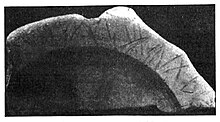You can help expand this article with text translated from
the corresponding article in Romanian. (February 2011) Click [show] for important translation instructions.
|
 A fragment of a vase collected by
Mihail Dimitriu at the site of Piroboridava (
Poiana, Galați,
Romania) illustrating the use of Greek and Latin letters by a Dacian potter (source:
Dacia journal, 1933) | |
| Location | Cetățuia de la mal, Piroboridava, [1] Poiana, Romania |
|---|---|
| Reference no. | GL-I-s-A-02989 [1] |
Piroboridava ( Ancient Greek: Πιροβορίδαυα) was a Dacian town mentioned by Ptolemy, [2] and archaeologically identified at Poiana, Galați, Romania. The second part name of the city Dacian dava shows significance of the tribal city.
It was rebuilt as a Roman fort around 101 AD in Trajan's Dacian Wars, situated a little below the confluence of the Trotuș and Siret rivers, on the left bank of the Siret, northwest of Poiana village. [3]
See also
Notes
- ^ a b "National Archaeological Record (RAN)". ran.cimec.ro. Archived from the original on 19 September 2012. Retrieved 17 November 2012.
- ^ Olteanu, Toponyms.
- ^ Vasile Pârvan, Castrul de La Poiana Şi Drumul Roman Prin Moldova de Jos, Analele Academiei Române, seria 11, tomul XXXVI. Memoriile Secţiunii Istorice Bucureşti https://www.scribd.com/document/16542208/Vasile-Parvan-Castrul-de-la-Poiana-%C5%9Fi-drumul-roman-prin-Moldova-de-Jos
References
Ancient
Modern
- Olteanu, Sorin. "Linguae Thraco-Daco-Moesorum – Toponyms Section". Linguae Thraco-Daco-Moesorum (in Romanian and English). Archived from the original on 16 July 2011. Retrieved 3 January 2010.
Further reading
-
 Media related to
Dacia and Dacians at Wikimedia Commons
Media related to
Dacia and Dacians at Wikimedia Commons
You can help expand this article with text translated from
the corresponding article in Romanian. (February 2011) Click [show] for important translation instructions.
|
 A fragment of a vase collected by
Mihail Dimitriu at the site of Piroboridava (
Poiana, Galați,
Romania) illustrating the use of Greek and Latin letters by a Dacian potter (source:
Dacia journal, 1933) | |
| Location | Cetățuia de la mal, Piroboridava, [1] Poiana, Romania |
|---|---|
| Reference no. | GL-I-s-A-02989 [1] |
Piroboridava ( Ancient Greek: Πιροβορίδαυα) was a Dacian town mentioned by Ptolemy, [2] and archaeologically identified at Poiana, Galați, Romania. The second part name of the city Dacian dava shows significance of the tribal city.
It was rebuilt as a Roman fort around 101 AD in Trajan's Dacian Wars, situated a little below the confluence of the Trotuș and Siret rivers, on the left bank of the Siret, northwest of Poiana village. [3]
See also
Notes
- ^ a b "National Archaeological Record (RAN)". ran.cimec.ro. Archived from the original on 19 September 2012. Retrieved 17 November 2012.
- ^ Olteanu, Toponyms.
- ^ Vasile Pârvan, Castrul de La Poiana Şi Drumul Roman Prin Moldova de Jos, Analele Academiei Române, seria 11, tomul XXXVI. Memoriile Secţiunii Istorice Bucureşti https://www.scribd.com/document/16542208/Vasile-Parvan-Castrul-de-la-Poiana-%C5%9Fi-drumul-roman-prin-Moldova-de-Jos
References
Ancient
Modern
- Olteanu, Sorin. "Linguae Thraco-Daco-Moesorum – Toponyms Section". Linguae Thraco-Daco-Moesorum (in Romanian and English). Archived from the original on 16 July 2011. Retrieved 3 January 2010.
Further reading
-
 Media related to
Dacia and Dacians at Wikimedia Commons
Media related to
Dacia and Dacians at Wikimedia Commons
